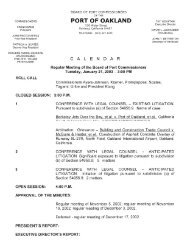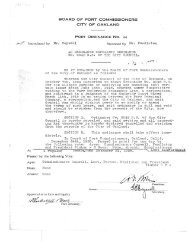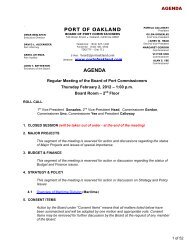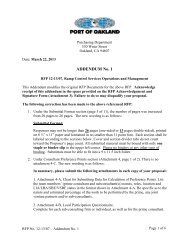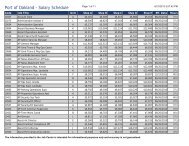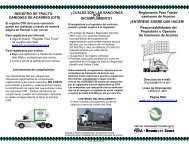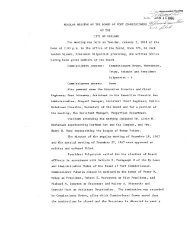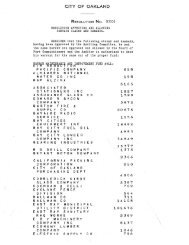Port-Wide Sewer System Management Plan(SSMP) - Port of Oakland
Port-Wide Sewer System Management Plan(SSMP) - Port of Oakland
Port-Wide Sewer System Management Plan(SSMP) - Port of Oakland
Create successful ePaper yourself
Turn your PDF publications into a flip-book with our unique Google optimized e-Paper software.
9.2.3 Hydraulic Model Development and Calibration<br />
A wastewater collection system model is a simplified representation <strong>of</strong> the real sewer<br />
system. <strong>Sewer</strong> system models can assess the conveyance capacity for a collection system.<br />
Also, sewer system models can perform “what if” scenarios to assess the impacts <strong>of</strong><br />
additional flows or modifications to the collection system.<br />
The <strong>Port</strong>’s hydraulic model combines information on the physical and operational<br />
characteristics <strong>of</strong> the wastewater system, and performs calculations to solve a series <strong>of</strong><br />
mathematical equations to simulate flows in pipes. The hydraulic model was developed<br />
based on available data collected from the <strong>Port</strong>’s, City <strong>of</strong> <strong>Oakland</strong>’s (City’s), and East Bay<br />
Municipal Utility District’s (EBMUD’s) utility maps, design drawings, lift station summaries,<br />
field surveys, and appropriate assumptions.<br />
Model calibration is a crucial component <strong>of</strong> the hydraulic modeling effort. Calibrating the<br />
model to match data collected during the flow-monitoring program ensures the most<br />
accurate results possible. The calibration process consists <strong>of</strong> calibrating to both dry and wet<br />
weather conditions. For this project, both dry and wet weather flow monitoring were<br />
conducted. Dry weather flow (DWF) calibration ensures an accurate depiction <strong>of</strong> base<br />
wastewater flow generated within the study area. The wet weather flow (WWF) calibration<br />
consists <strong>of</strong> calibrating the hydraulic model to a specific storm event to quantify the peak and<br />
volume <strong>of</strong> I/I into the sewer system. The amount <strong>of</strong> I/I is essentially the difference between<br />
the WWF and DWF components.<br />
A detailed summary <strong>of</strong> the model calibration process, including the results <strong>of</strong> the model<br />
calibration, is included in Appendix M for reference.<br />
9.2.4 Evaluation<br />
Following the dry and wet weather flow calibration, a capacity analysis <strong>of</strong> the <strong>Port</strong> collection<br />
system was performed. The capacity analysis entailed identifying areas in the sewer<br />
system where flow restrictions occur or where pipe capacity is insufficient to convey design<br />
flows. <strong>Sewer</strong>s that lack sufficient capacity to convey design flows could produce backwater<br />
effects in the collection system and potentially cause SSOs. The sewer system was<br />
evaluated based on planning criteria presented in Section 9.2.1 and Appendix M.<br />
For existing conditions, the capacity analysis consisted <strong>of</strong> applying the 10-year, 24-hour<br />
design storm to the existing average day flow (ADF) to simulate the peak wet weather, or<br />
design, flow condition. This is the maximum hourly flow that is expected to occur in the<br />
collection system. <strong>Sewer</strong>s with flows exceeding the maximum d/D under design flow<br />
conditions were identified and improvement projects to mitigate existing capacity<br />
deficiencies were developed. This process was then repeated for the anticipated flow<br />
conditions at year 2030.<br />
May 2010 9-5<br />
pw://Carollo/Documents/Client/CA/<strong>Port</strong> <strong>of</strong> <strong>Oakland</strong>/8239A00/Deliverables/Ch09 (FinalA)



